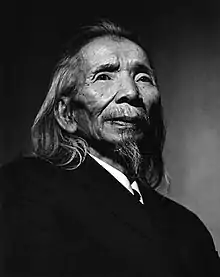Văn Cao
Văn Cao (born Nguyễn Văn Cao, Vietnamese pronunciation: [ŋʷjə̌ˀn van kaːw]; 15 November 1923 – 10 July 1995) was a Vietnamese composer whose works include Tiến Quân Ca, which became the national anthem of Vietnam.[2][3] He, along with Phạm Duy and Trịnh Công Sơn, is widely considered one of the three most salient figures of 20th-century (non-classical) Vietnamese music.[4]
Văn Cao | |
|---|---|
 | |
| Born | Nguyễn Văn Cao 15 November 1923[1] Hai Phong, French Indochina |
| Died | 10 July 1995 (aged 71) Hanoi, Vietnam |
| Nationality | Vietnamese |
| Occupation | Composer |
| Known for | Composing music |
| Notable work | Tiến Quân Ca |
Văn Cao is a Hai Phonger. He was also a notable poet and a painter. In 1996, he was posthumously awarded the Hồ Chí Minh Prize for Music.[5]
Career
After the Nhân Văn–Giai Phẩm affair, a movement for political and cultural freedom in 1956, he had to stop composing. Most of his songs, except Tiến Quân Ca, Làng Tôi, Tiến Về Hà Nội, and Trường Ca Sông Lô were prohibited in North Vietnam.
All of his songs were once again authorized in Vietnam until after the Đổi Mới, 1987.
In 1991, the American composer Robert Ashley composed the solo piano piece Văn Cao's Meditation, which is based on the image of Văn Cao playing his piano.
Works
Songs
- Bắc Sơn (1945) (song about Bắc Sơn Uprising, was originally written for the same name Bắc Sơn play of Nguyễn Huy Tưởng)[6]
- Bài ca Chiến sĩ Hải quân (1945) ("Song for marines")
- Bến xuân (1942) ("Spring river dock", music by Văn Cao, lyric written together with Phạm Duy)
- Buồn tàn thu (1939) ("Sadness at the end of autumn", the first song of Văn Cao)
- Chiến sĩ Việt Nam (1945) ("Vietnamese soldiers")
- Cung đàn xưa ("The old tune")
- Đàn chim Việt (1944) ("Vietnamese flock of birds" - rewritten lyric from Bến xuân)[7]
- Đêm sơn cước ("A night in the mountain")
- Gò Đống Đa (1942) ("Đống Đa Mound")
- Hải quân Việt Nam hành khúc (1945) ("Vietnamese navy march")
- Hò kéo gỗ Bạch Đằng Giang (1941)
- Không quân Việt Nam hành khúc (1945) ("Vietnamese air force march")
- Làng tôi (1947) ("My Village")
- Mùa xuân đầu tiên (1976) ("The first spring" - after Reunification Day, it was also the last song of Văn Cao)[8][9]
- Ngày mai ("Tomorrow")
- Ngày mùa (1948) ("Harvest")
- Suối mơ ("Dreamy stream")
- Thăng Long hành khúc ca (Thang Long marching song)
- Thiên Thai (1941) ("Eden")
- Thu cô liêu
- Tiến Quân Ca (1944) (Army marching song)
- Tiến về Hà Nội (March on Hanoi)
- Tình ca Trung du (Trung du's love song)
- Trương Chi (1943) ("Not a word but a name")
- Trường ca sông Lô (1947) ("Lô river epic")
Poems
- Anh có nghe thấy không (Feb 1956) ("Do you hear?". Published in Giai phẩm Spring)
- Những người trên cửa biển (1956) ("People at the sea gate", Epic about people of Hải Phòng)
- Lá (1988) ("Leaves", poetry collection)[10]
Paintings
- Cô gái dậy thì (Puberty girl)
- Thái Hà ấp đêm mưa (Rainy night in Thái Hà hamlet)
- Cuộc khiêu vũ của những người tự tử' (1944) ("Dance of the suicides")[11]
References
- "100 years anniversary of musician Văn Cao's born". vietnamnet.vn. Retrieved 16 September 2023.
- Dale Alan Olsen Popular Music of Vietnam: The Politics of Remembering 2008 "Văn Cao" p36-37, p129-130
- Shepherd Continuum encyclopedia of popular music of the world "Văn Cao"
- "Trinh Cong Son's love songs hit Hue palace". Tuổi Trẻ. 30 March 2011. Archived from the original on 2 April 2011.
- "The song go along the timeline - Musician Văn Cao". bcdcnt.net. Retrieved 25 January 2022.
- "Bắc Sơn - here mountain and forest of the battle zone". cand.com.vn. Retrieved 7 January 2022.
- "The song go along the timeline - Vietnamese flock of birds". bcdcnt.net. Retrieved 8 January 2022.
- "The untold story about The first spring". tuoitre.vn. 17 November 2019. Retrieved 4 January 2022.
- "The first spring and the prophet of the age". vnexpress.net. Retrieved 5 January 2022.
- "The best poems of poet Văn Cao". thica.net. Retrieved 9 January 2022.
- "Song go along the timeline - Trương Chi of love songs and epics". bcdcnt.net. Retrieved 23 January 2022.